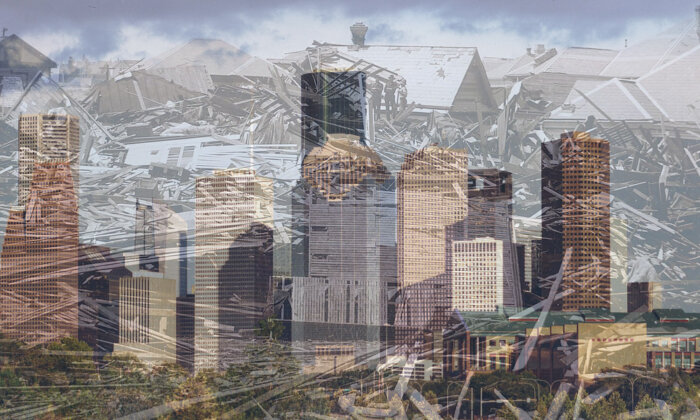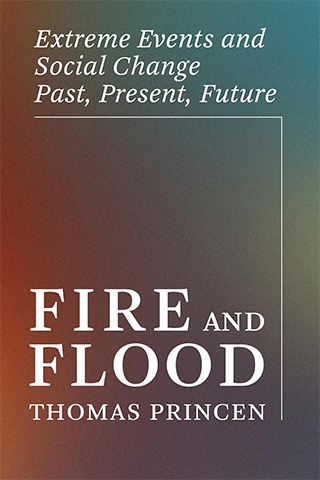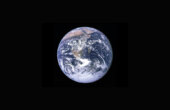Galveston’s Boom-and-Bust History of Migration

Galveston is a landscape of coastal lowlands, from a barrier island in the Gulf of Mexico to a bay fed by rivers, aquifers and lots of rain. It is also a wildlands, teeming with fish and shrimp, birds and deer, marsh and grass and forest, and a hydraulic system of two precious liquids: water aboveground, oil below. Seen broadly, Galveston is a migratory stage — birds on their flyways, fish going from spawning grounds to feeding grounds, humans foraging, trading as winds and silt permit, settling until the land sinks or floods, resettling out of harm’s way.
And, of course, Galveston’s metropolitan center, Houston, is one of 20th-century America’s great cities, a place of great opportunity and great wealth and little government restriction, a network of highways and runways and railroads, a flow of people and peoples, ideas and capital, a place on the move. It is a place where people from all over the country, Mexico, and elsewhere, rich and poor, highly educated and less educated, can make a living, sometimes a really good living.

The story of “Galveston” — that is, Galveston Island, Galveston Bay, Baytown, Houston, the Woodlands — is conventionally told as one of pioneering and industrializing, in short as westward expansion and economic growth. What’s more, the telling has typically been done not just to describe but also to prescribe, to promote. As the Houston petroleum historian Joseph A. Pratt puts it, “‘Opportunity’ and ‘expansion’ early on became the central tenets of Houston’s religion of boosterism. Whatever it took to foster economic growth in the region would be done.”
Even in the aftermath of Harvey, as the Texas author Anis Shivani has observed, Harvey was “solicited to boost the city’s mythology of hardscrabble frontiersmanship and voluntarism operating under minimalist regulation.” Houston is indeed a story of frontiersmanship, of creating frontiers of prosperity out of barrier islands and inland bays and underground minerals and of developing powerful technologies and flights into space. From the perspective of natural-resource grounding and human ecological adaptiveness, though, Houston is a story of migration. Even after the elimination of First Peoples, the enslavement of kidnapped African peoples, and the mining of water, sand, oil, and gas, the migration is not yet complete.
At Galveston, the impact of colonization was the displacement of First Peoples so that Second Peoples could set up shop for maximum wealth generation.
The earliest peoples arrived centuries ago, maybe millennia ago, and can be called the “First Peoples.” Another wave of people, mostly of European ancestry, what can be called the “Second Peoples,” reached the outer shores of this land used by the First Peoples. Upon contact, the two traded for a time, but because the Second Peoples carried a model of settlement from the east — that is, from the eastern seaboard of North America and Europe — and the First Peoples carried a model of seasonal occupation, the Second eventually displaced the First. Seafaring vessels and advanced weaponry, not to mention ideas such as racial superiority and manifest destiny, played their role.
The significance of the displacement is not just that a cooperative mode, trade, devolved to a competitive mode and exclusionary occupation. It is that First Peoples’ extractive mode — hunting, fishing, and gathering according to seasonal availability and conducive weather — became a subordinate strategy to Second Peoples’ extractive mode — settle year-round, clear land, drain wetlands, channel rivers, and grow export crops such as cotton and sugar to sell to distant markets. First Peoples return year after year, unable to fish out or overharvest the bounty they find because it regenerates year after year. Second Peoples extract until returns diminish beyond the profitable point, and then they move on.
Both modes are adaptive, but only the first can be sustained in place over the very long term. Around the world, write the ecologist Madhav Gadgil and the sociologist Ramachandra Guha, “agricultural societies which newly colonize lands held by gatherers have had a dramatic ecological impact even in the short run — transforming the landscape, exterminating certain species and depleting others.”
At Galveston, that impact of colonization was the displacement of First Peoples so that Second Peoples could set up shop for maximum wealth generation. Galveston Island was the obvious place to build a port: ideally located at the juncture of sea and land and protected from the ocean on one side by the barrier island itself and on the other by a smaller island in the bay. Its 19th-century competitor, Houston, had the Brazos River, but sandbars at its mouth and shallow waters limited its use for shipping. In short, writes Pratt, “the [Houston] region’s waterways did not provide dependable, efficient transportation to carry cotton crops from the Brazos bottom to market.” What’s more, “the use of wind, water, wood, and muscle power limited [Houston’s] development in a sparsely settled region on a broad expanse of marshland and prairie.” Instead, as the boosterist vision has it, wealth goes through and concentrates in the entrepôt; boom times are ahead; Galveston is the next New Orleans, if not New York City or London. Galveston became the most populous city in Texas until nearly the end of the 19th century and for a time was the world’s largest cotton-shipping port. Then nature stepped in, puncturing the vision.
The Great Storm of 1900 may not have been a surprise to First Peoples, who eschewed permanent settlement on a barrier island, but it was to those whose boosterist dreams were based on truly well-protected ports such as New York City and London. The Great Storm could have been a day of reckoning. Galveston — a sandy barrier island prone to shifting with storms and ocean currents — was no place to build a permanent settlement. Indianola should have been proof enough. If a great city were to exist on the Gulf Coast, it would have to be New Orleans, being both protected (mostly) and at the mouth of America’s greatest river system.
The lesson of the Great Storm for First Peoples was likely confirmation of what they had known and passed from generation to generation: The island and bay are bounteous places, but they can be deadly as well. Visit, even camp there for short periods, but do not stay, especially in late summer and early fall. The lesson for Second Peoples was different: Rebuild for some, migrate farther inland for others. The upper bay may not be ideal, but at least it is better protected; with precautions and, say, dredging, a permanent year-round settlement is possible. In other words, continue to construct a frontier economy, continue to extract and expand, just locate farther from those destructive storms. Little could they know in the 19th century that the frontier mode could be extended a full century and more with underground extraction. And little could they know in the 19th century that, like so many migrations, each phase is only temporary, and each place, from Galveston to the uplands, is only a waystation until people learn to live in their place, until the economy matures past mere extraction.
And so, Second Peoples did settle, as pioneers do, but it was settlement only of a sort. The resource mode was still extraction. And did they extract. At first, before the Great Storm, they extracted the usual frontier items that could be commodified and sold to markets as far as New York and even Europe: furs, hides, timber, fish. Then they cleared land and enslaved people to raise commodity crops, especially cotton and sugar. “Both before and after oil,” Pratt writes, “the transportation and processing of raw materials for export constituted the engine of growth” for the Houston area. What is more, the “emphasis [was] on harvesting resources as rapidly as possible with no concern for the long-term depletion of these resources. Within a large region with relatively few people, few questioned this process. Cotton growers depleted the soil and then moved on. The rapid clearcutting of the pines and hardwoods of East Texas for short-term profit went forward with little thought about the future.” In short, business as usual was frontier extraction from the days of the earliest colonizing right through the 20th century to today.
Pratt poses the essential question, essential not just to explain 20th-century Houston, Pratt’s purpose, but also to imagine a postfrontier Houston, or “Galveston,” my purpose: What would have happened “had oil not been discovered near Houston”? Because Pratt’s concern is patterns of 20th-century energy and economic development, he answers that coal dependency would have prevented rapid economic development. But a major concern of my study is the transcendence of fossil-fuel dependency. More than mere conjecture, posing the what-if question allows us to use history to imagine the 21st-century transition after fossil-fuel dependency. If oil had not been found at Spindletop 80 miles east of Houston right after the Great Storm in 1900, that might have been the end of the story. Or, as Fortune magazine put it in 1939, “Without oil Houston would have been just another cotton town.”
Oil is the quintessential environmental signal that says, as positive feedback via power and wealth kick in, “Extract more.”
“Galveston,” centered on a barrier island, would be yet one more Gulf Coast town struggling to develop and maintain its population. And if for some reason the land subsided, the groundwater got polluted, and torrential rainfall inundated the area repeatedly, then settlers would have moved farther inland.
What is more, to extend this imaginative rewrite of history, Second Peoples, situated inland, would have ventured seasonably into the bay all the way to Galveston Island to fish and hunt and collect vegetation. In short, they would have adapted to “Galveston” much as the First Peoples did. In fact, if the history of fire adaptation in North America is any guide, Second Peoples, upon settling, would have learned such a resource mode from the First Peoples.
“The evidence suggests that early European colonists were generally ignorant (or in denial) of wildland fire and of methods to control it,” writes the preeminent fire and forestry historian Stephen J. Pyne. “It was from the Indian — into whose fire environment they moved — that the European immigrants learned basic survival skills.” Likewise, the evidence from Galveston suggests that 19th-century colonizers were ignorant of extreme weather on a coastal barrier island. What’s more, even after the worst natural disaster in U.S. history, they retained that ignorance (or denial) right into the 20th century, buoyed by boosterist calls for greatness and the belief that they could control it all. Only now are some people, although still a small minority it seems, entertaining the idea that all cannot be controlled. What is more, they are learning from history and the adaptiveness of early peoples.
In this futurist exercise, I try to imagine how it might have been, how, if settlers had actually aspired to adapt to the environment, not shape it to their desires and ambitions, things might have been different before and especially after the Great Storm. But, of course, history didn’t happen this way. Immediately after the hurricane, oil transformed the place, as it does every place where it is discovered. Oil is the quintessential environmental signal that says, as positive feedback via power and wealth kick in, “Extract more.” Thus it is that Houston became a boomtown with Spindletop and Goose Creek and other nearby strikes. When those fields played out, Houston extended its extractive reach, both physical and technological, across the state, the region, and, eventually, the world. Houston proclaimed itself the “oil capital of the world,” not just for the extracting and refining in the region but for the expertise developed there that could be applied anywhere, all over the world.
And so anywhere became the operative geographic term for 20th-century Houston, now the center of Galveston. Houston became a city simultaneously of a place on a bayou near a bay and of no place, on the map yet anywhere. Houston was no longer grounded in a particular place, a nexus of ocean and land, of warmth and freshwater, of game and timber, of cotton and meat, of settlements and wildlands. Like so many cosmopolitan centers, it could power its way out of the constrictions of limited port capacity (with dredging and channelization), out of its otherwise backwater location (first with railroads, then with highways and airports), out of seasonably limited freshwater (with reservoirs), out of the heat (with air-conditioning). In short, to be the “energy capital of the world” has meant that what Houston did — extract and refine and consult — could, in principle, in the late 20th and early 21st centuries, be done anywhere.
Houston was simultaneously of a place and of no place. Oil was global. It came out of the ground all over the world and went into a global market all over the world, used by anyone, all over the world. “In the global market, the nationality of the resource is of little relevance,” said Rex Tillerson, a former CEO of ExxonMobil. “Energy made in America is not as important as energy simply made wherever it is most economic.” Like money itself, the “economic,” the efficient, the wealth-generating matter, not the place. And if the place doesn’t matter, then the water and the soil, the hurricanes and rainstorms don’t matter. New sources can always be procured from some other place; extreme events can be defended against or endured.
The transformation brought about by oil was momentous for 20th-century Houston, the city experiencing population growth from some 45,000 to 1.8 million, a growth rate faster than that of any other U.S. city. But from this study’s natural-resource, adaptive, and migratory perspective, the transformation is far more than demographic and economic. It is an extension of the frontier, a temporary one, albeit occurring over more than a century. Behaviorally and institutionally, it is the prolongation of the last stage of a boom that, like all mining operations, eventually goes bust. Economically, it is the perpetuation of an extractive economy. Politically, it is the grasping for power that empires always do, both in their ascent and in their decline. Ultimately, though, nature does bat last. It does assert the placefulness of its denizens, irrespective of financial gain, irrespective of economic and political power, let alone of the physical power of energetically dense fuels.
And so the oil-and-gas rush consumed the region. It consumed, ecologically speaking, freshwater supplies, causing the land to subside, and in turn consumed an oil field and a neighborhood. It consumed land and water with its toxic dumping. It consumed the climate-stabilizing components of the atmosphere and oceans. And maybe, just maybe, it will consume the “pioneering spirit,” what for many peoples has been a colonizing spirit, and what for future generations will be a depleting spirit.
There is no turning back, no getting back to normal, where normal is defined as boom times forever.
In recent years, the boom has indeed begun to shift to bust. If the boom phase spanned more than a century, then the bust phase will probably do likewise. But what this imaginative exercise evokes is a recognition that the bust is underway and with it the completion of the migration. What is more, for the purpose of effecting a positive transition, which is a primary task in this study, it evokes the need to read the environmental signals, both experiential and scientific. Subsiding land, repeated “500-year” floods, more frequent and intense hurricanes, and even water pipes bursting in cold snaps are signals of this boom-to-bust phase shift. The shift can be resisted or, most popularly, denied. But there is no turning back, no getting back to normal, where normal is defined as boom times forever, where fossil-fuel extraction, conversion, and combustion are the modus operandi of millions of people in an otherwise unforgiving environment.
In this respect, “Galveston” is only a microcosm of a world addicted to oil. It may be a forerunner of what’s to come around the world, especially a world that has organized itself as if endless material expansion on a finite planet is possible. Houston may be the “energy capital of the world,” but it has been a world almost entirely dependent on fossil fuels. Some 85 percent of all energy consumed worldwide is from fossil fuels. That means that when the low-cost and easily withdrawn stuff runs out, when the energy and capital to get it no longer justify the extraction, when the bill for true costs — costs to the land and water locally, costs to the climate system globally — come due, as this story suggests they are, boom times are over. The migration, delayed for a century, will resume.
What might that resumed migration look like? We can only speculate, but such is the method of a futurist exercise. Many of Houston’s occupants will migrate out as an economy grossly propped up by near costless fossil-fuel extraction, conversion, and combustion winds down. Just as Galveston Island is propped up physically and economically, “Galveston” the region, the cultural area, the economic engine is propped up by its own unsustainable physical systems, namely those of oil and endless economic expansion. Those who remain — descendants of Native and enslaved peoples, of Europeans, and, most recently, of people from all over the world — will adapt to a diminished landscape. They will adapt or move on. But in a world full of human activity and impact, moving on cannot preclude eventually adapting. Significantly, adapting does not mean installing bigger pumps and better filters and moving water to suit the new circumstances, what I’ve termed “defensive adaptation.” Rather, here adapting is adjusting to the environment, to what nature has given and humans have altered. Here, adapting to is the response to a century and more of domination of; it is what surplus-seeking, expansionist societies, especially fossil-fueled societies, have been able to avoid for a couple centuries.
Thomas Princen is a faculty member at the School for Environment and Sustainability at the University of Michigan. He is the author of several books, including “The Logic of Sufficiency,” “Treading Softly,” and “Fire and Flood,” from which this article is excerpted.



